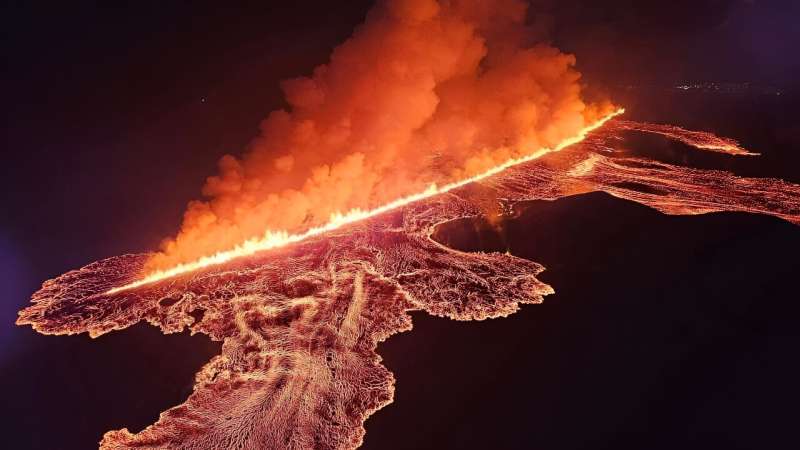This article has been reviewed according to Science X's editorial process and policies. Editors have highlighted the following attributes while ensuring the content's credibility:
fact-checked
reputable news agency
proofread
Iceland's volcanic eruption slows as lava flows from second fissure

Icelandic authorities said Friday that a second fissure had formed on the southwestern Reykjanes peninsula, but volcanic activity had decreased after lava started spewing forth for the sixth time in the region since December.
After weeks of warnings, the Icelandic Meteorological Office (IMO) said Thursday that a new eruption had started at 9:26 pm (2126 GMT) that evening, following a series of earthquakes.
Video images showed orange lava bursting out of a long fissure, which the IMO estimated to be 3.9 kilometres (2.4 miles).
Early Friday, the IMO announced on social media that a second fissure had opened up to the north of the original one.
In an later update, the agency said that "the intensity of the eruption has decreased significantly since yesterday."
It added that the "most active fissure is the one which opened during the night."
This is the sixth eruption to hit the area since December, coming just two months after the end of a previous eruption that lasted more than three weeks.
The latest eruption occurred north of previous eruptions and since no lava flowed south it posed less of a risk to the nearby fishing village of Grindavik, which was evacuated Thursday evening.
The chief of police of the Sudurnes region, Ulfar Ludviksson, told Icelandic media that the 22 or 23 houses in the village were currently occupied.
Most of Grindavik's 4,000 residents had evacuated in November, prior to a December eruption, and while residents have since been allowed to return in between eruptions, only a few have opted to stay overnight.
The IMO also noted that there would be "northerly and northwesterly winds at the eruption site" until Saturday, which therefore would spread gas pollution from the site south and southeast -- carrying it out to sea.
The Reykjanes peninsula had not experienced an eruption for eight centuries until March 2021.
Further eruptions occurred in August 2022 and in July and December 2023, leading volcanologists to warn that a new era of seismic activity had begun in the region.
Iceland is home to 33 active volcano systems, the highest number in Europe.
It straddles the Mid-Atlantic Ridge, a crack in the ocean floor separating the Eurasian and North American tectonic plates.
© 2024 AFP



















